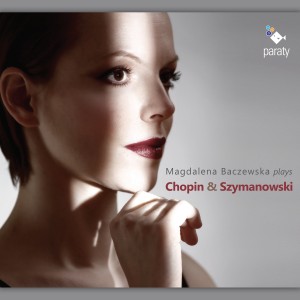
The works on this album were chosen to show the connection between the music of two Polish-born composers: Fryderyk Chopin (1810-1849) and Karol Szymanowski (1882-1937). On one end of the spectrum lies Szymanowski’s lifelong reverence for the musical language of Chopin, starting with his first compositional steps, Preludes op. 1, and culminating decades later in Mazurkas op. 50 and op. 62. On the other end lies the fascination with Polish folklore, developed independently by each composer, drawing on different musical styles experienced in different regions. While folklore was not the sole artistic influence, both composers explored it in mature stages of their compositional output.
Published in 1841, Chopin’s Prelude op. 45, is arguably one of his most enigmatic works. Improvisatory in nature, the thematic material constantly modulates, and is difficult to grasp. Chopin presents the material in tidal waves, creating an effect of deep sighing. The exploration of color and bold harmonic progressions seems to take priority over the melodic contour. This is perhaps why Alfred Cortot wrote about the piece in his 1947 preface to a performing edition of Chopin’s selected works: “It is not so much the culmination of a Romantic aesthetic as the promise of an aesthetic to come.” This Prelude is a look toward the future, paving the way for the highly chromatic music of Wagner and the lusciously colored sonorities of Debussy.
In his Preludes op. 1, Szymanowski draws from the legacy of Fryderyk Chopin’s late style. He is also fascinated by the music of Richard Wagner, Richard Strauss. Moreover, Szymanowski’s compositional debut reveals familiarity with Alexander Scriabin’s Preludes op. 11, which themselves are an evident homage to Chopin’s Preludes op. 28. This cycle of nine powerfully lyrical vignettes was published at the time when eighteen-year old Szymanowski was entering the Warsaw Conservatory. Although his formal education on counterpoint was yet to begin, the Preludes already show successful attempts at contrapuntal writing. At the center of the cycle stands the fifth Prelude in D minor, full of penetrating drama and of virtuoso brilliance, in idiom reminiscent of Scriabin’s Prelude op. 11, No. 6. Arthur Rubinstein, a champion of Szymanowski’s music, and later the dedicatee of Mazurkas op. 50, wrote in his memoirs: “It is impossible to describe our amazement after playing the first few bars of the Prelude. This music was composed by a master!”
Published the same year as Prelude op. 45, Ballade op. 47 owes its inspiration to an epic poem by Adam Mickiewicz, Undine [Świtezianka]. Chopin did not assign a program to any of his Ballades, and generally shied away from programmatic music. At the same time, the composer was the first to assign the term ballade, usually used in poetry, to a piece of instrumental music. Robert Schumann sensed and admired the ‘breath of poetry’ in this piece. Aside from the narrative qualities, Chopin masterfully manipulates the thematic material: the opening theme, simple yet filled with expectation, is later transformed into an ecstatic finale.

